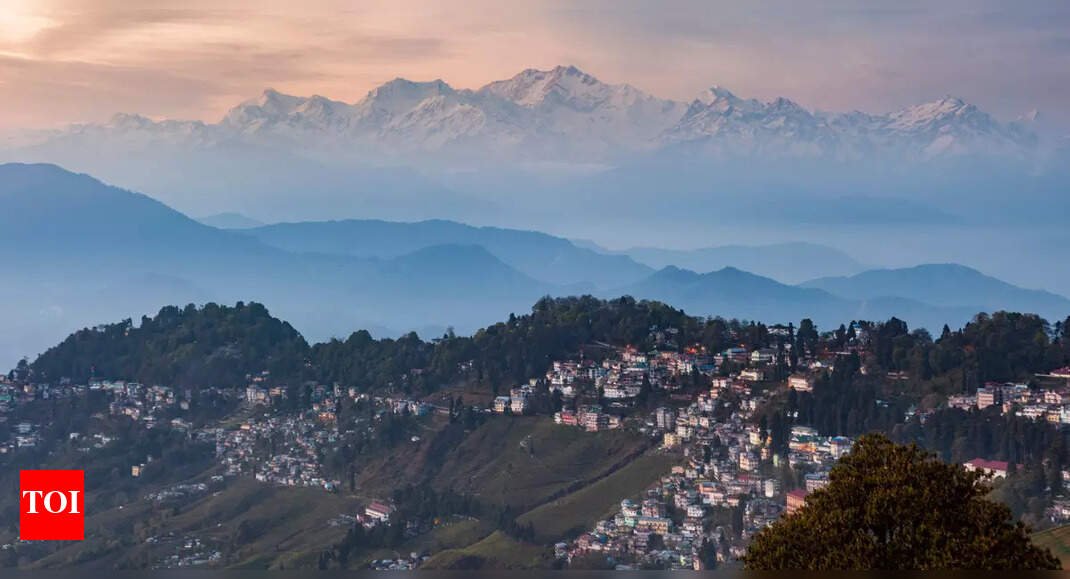Travel Guides & Articles
Now Air India Alters Flight Routes After Ahmedabad Air India Crash: Know The Details

Saturday, July 12, 2025
The Sardar Vallabhbhai Patel International Airport catastrophe, which saw an Air India flight tragically crash and thus send the entire flying fraternity into panic and despair, not only shocked the nation, but its impact has also created a kind of ripple effect on its travel and tourism sectors, which stretch over a number of cities, namely Delhi, Mumbai, Bengaluru, Chennai, and Jaipur. The impact caused by this deadly crash consists of large changes to flight schedules, changes to routings, and monetary losses by airlines and ground-level organizations that base their entire business on flying.
The disaster not only ignited concerns about flying’s safety, but has led to an on-the-spot reorganization of flight schedules. As an immediate consequence, countless airlines, from Air India to its competitors, have been spurred to shift their routes, cancel certain flights, and, for many, modify their lines of business. For frequent fliers, not only are the changes bothersome—they shed light on the precarious state of the flying business and its ability to recover from such catastrophic events.
Air India Crash: What Happened?
On 12th June, an Air India flight that was flying from Mumbai to Ahmedabad was among those that had an accident while landing at Sardar Vallabhbhai Patel International Airport, and there were several casualties and a temporary disruption of airport operations. The incident has elicited an expression of sorrow all over the country as the flying fraternity, authorities, and civilians pay their respects and show their sympathies to the bereaved families.
The accident, which occurred on the late evening, was investigated by the Directorate General of Civil Aviation (DGCA), and preliminary reports verify that unfavorable weather and likely technical failures might have caused the disaster. As the authorities toil day and night to identify the cause of the accident, the incident has placed the entire flying industry in spotlights, and acute doubts have arisen regarding flight security and the readiness of the airports to encounter sudden emergencies.
Air travel to Ahmedabad, and even to nearby cities like Mumbai and Delhi, was badly hit following the crash. As many Air India flights have been grounded to conduct safety examinations, the situation has affected businessmen and women, tourists, and families who are relying on scheduled flights to maintain their private and work commitments.
Major Disruptions and Flight Schedules Route Changes
Subsequent to the crash, numerous major carriers, like Air India, IndiGo, and SpiceJet, have been forced to adjust flights and flight schedules. As a result of Ahmedabad airport’s closure while repairs and security checks take place, flights from every corner of the nation are facing extensive delays and flight cancelations.
While Air India said they will resume all domestic flights in a matter of days, other airlines have had to work overtime to catch the increase in travel from affected persons. The result has been universal demands on flights to and from large cities such as Delhi, Mumbai, Bengaluru, and Chennai, where passengers are seeking alternative means to travel.
For instance, flights from Ahmedabad to Delhi and Mumbai by Air India have been diverted to Sardar Vallabhbhai Patel International Airport, which has resulted in congestion at other airport terminals. Airlines responded to this by launching new flights to handle the sheer number of passengers. For instance, SpiceJet has started special flights from Ahmedabad to Jaipur and IndiGo has launched flights from Bengaluru to Mumbai.
Even so, however, the added capacity on those new lines has failed to match the demand. This has led to stranded travelers, many of whom experience several hours-long holds, unintended layovers, or rescheduled journeys altogether. On a very few occasions, regional airports are overwhelmed by rerouted flights, which create extensive delays and more operational headaches.
Impacts on Regional Economy and Airline Industry
The economic effects from the loss of Air India stretch much further than the airlines alone. For cities such as Ahmedabad, which boasts an up-and-coming tourism industry, the loss offlight service on such short notice is already negatively affecting them. Ahmedabad, one of the major centers and cultural hotspots, relies on flying to attract tourists and corporate executives. When so many flights have been canceled or re-directed, the local economy was directly affected.
The cities’ tourist attractions, which depend on day-to-day flights, have also been affected. The tour and travel players within such regions are suffering from cancellations and rescheduling, and tourists are unable to adjust to the changing schedules of flights. The spillover effects are further being felt within the hotel sectors, transport companies, and tourist arrival-dependent hospitality businesses.
Also, since other carriers will need to increase capacity and reschedule flights, increased costs of operation will tend to have an effect on prices within the near future. Passengers may face increasing flight costs and lowered seat entitlement on other flights, compounding an already knotty situation further.
Navigating the Change: What Travelers Need to Know
For those passengers who are to travel by flight from Ahmedabad or whose flights have been interrupted, staying updated is crucial. The best way to avoid further distress is to keep consulting airlines and flight service companies to stay informed about existing flight status and changes in flight routes.
The passengers traveling to cities like Delhi, Mumbai, Bengaluru, and Chennai should also be informed about rerouting of flights and altered schedules. The cities’ airport traffic will presumably increase, and the passengers should arrive early to compensate for likely delays and security checks.
The airlines are doing every bit to reduce disruptions, but passengers need to take actions to make travel plans work smoothly on their end too. Phoning airlines to arrange to have flights rearranged or to consider alternative flight schedules is the advisable thing to do if your flight has been impacted. And, if you are an international traveler, expect longer connections and longer waiting, since the effects of these delays percolate through to international flights too.
Air Travel Safety and Regulation Enters a New Era
The disaster has also triggered new conversation on Indian airlines’ safety. While accidents on this massive scale are not frequent, the disaster serves as a wake-up call on the need to comply with strict norms on safety and to upgrade infrastructure continuously to address the growing demands of the flying industry.
The DGCA will most likely follow stricter safety regulations following its probe into the reason behind the crash. These include stiffer maintenance checks on planes, improved pilots’ training, and upgraded weather forecasting equipment to better protect travelers in the years ahead.
The international and Indian airlines market will probably reassess its own regulations on safety while this probe runs its course. For consumers, this may translate to tighter regulations and longer lines at airport waiting areas as a focus on security and safety continues to build following this fatal crash.
Conclusion: Looking Ahead to Safer and More Reliable Travel
As the flying world recovers from this disaster, the traveling public must remain informed and calm. The recovery will not come quickly, and there will be significant operational and logistics hurdles to overcome, but this disaster provides an opportunity to redetermine industry priorities and rebuild flying more safely, efficiently, and predictably.
For the affected persons by the flight schedule disruptions, the entire experience serves as a bitter reminder that travel plans can change within a matter of hours. The future direction of Indian flight travel, particularly to cities like Ahmedabad, Delhi, Mumbai, Bengaluru, Chennai, and Jaipur, will certainly be shaped by lessons from this experience.
As the flying world attempts to bounce back, one thing has become absolutely clear: traveler, airline, and city resilience will need to power the eventual recovery. For now, though, there’s a need to stay informed, stay current, and, above all, stay safe during this difficult period.
Travel Guides & Articles
Why Northeast India needs to be on top of India’s tourism map this year |

Vacationing in India, is always about wandering off to the dry deserts in Rajasthan to the huge lagoons of Kerala to snow-capped peaks of Himachal. Despite all this, the Northeastern part of India is quite unexplored and has some of the most breathtaking landscapes and cultural treasures of the country. This part, including the so-called seven sisters: Arunachal Pradesh, Assam, Manipur, Meghalaya, Mizoram, Nagaland, and Tripura-Apart from Sikkim-has finally been put on the map for must-visits.
Raw, Untouched Nature
The North East of India is probably a land of the last unknown natural landscapes and undisturbed raw beauty. From rolling tea gardens of Assam to the ethereal living root bridges in Meghalaya, those from Kanchenjunga-housed Sikkim to Arunachal’s mystical-yet-iconic monasteries realize that the region indeed gives you every type of landscape imaginable. Those addicted to nature can trek through alpine meadows, visit dense forests abundant in biodiversity, or take river cruises on the mighty Brahmaputra. Away from the commercialized tourist circuits, the Northeast has that remaining charm and tranquility to retain.
A Cultural Kaleidoscope
The Northeast is a mix of all ethnicities, customs, and languages. Over 200 tribes inhabit this set of states, each practicing its local customs, dyeing, and craft; festivals and culinary flavors; it is an experience all by itself. The festivals like Hornbill of Nagaland, Sangai of Manipur, or Bihu of Assam offer spectacular glimpses into day-to-day life. Here one may sample native art forms, folk music, and crafts that are very ancient but stand apart from mainstream Indian culture.Read more: Beyond Marine Drive: 10 Mumbai parks best for family outing
Adventures Await
This is the region for adrenaline junkies. Right from cave explorations in Meghalaya to white-water-rafting in Arunachal, paragliding in Sikkim, or mountain biking on tough tracks in Nagaland, this part of North East India truly has it all for adrenaline junkies. The untouched terrain safeguards the purity of any such adventure experience across here.
Sustainable and Responsible Tourism
Conscious traveling is hitting zeniths, and drawing up an ecology road for the North East is a classic example of sustainable travel. The region’s community, deep-minded of ecology, has been carrying out ecologically conscious life for centuries. Choosing from different modes of responsible tourism is one of doing the eco-homestays, eco-camps that save the environment while restoring a livelihood for the locals.
Exploring Culinary Delights
North East denotes a plethora of culinary traditions, with each being a figure of a particular cultural identity. Each state has its culinary specialties-from from Assam fish curries that are sour and hot, to smoked meat and chilling atmosphere of Nagaland; from jadoh rice of Meghalaya, to momos and thukpa of Sikkim that are highly famous. Neither a few fresh herbs here, nor a couple of bamboo shoot there, in combination with those local spices, would guarantee that the food is worth reminiscing. So for those wanting to taste some real, off-the-beaten-path flavors-the region is a ready-made paradise to go to.Read more: 8 incredible safari tours around the world that aren’t about Big Cats
Boosting Connectivity and Infrastructure
Now with the availability of direct flights to such destinations from prime locations in the country such as Delhi, Mumbai, and Bengaluru, it is better observed with more accessibility. Improved road network, new airports, improved rail connectivity are all making the region ever more accessible. The “Act East Policy” of the government has also ensured increased investments for infrastructure, further opening gates for tourism. Easy access has been made possible currently because of new direct flights from metropolitan cities such as Delhi, Mumbai, and Bengaluru.
The Traveler’s Safe Haven
Perhaps due to not very many people being aware of the site, the Northeast really answers the description of a safest and most hospitable land for any traveler to venture into. The Northeast people, friendly and accommodative, are ever willing to share their culture with the outsiders. Single travelers, more often than not, especially female ones, rave about the safety and the sense of belonging they experienced when traveling in the region.
The Foreign Edge in Tourism
With international places becoming too pricey, North-East India can offer experiences at a fraction of the cost. It offers a pristine beauty that can compete with the alpine meadows of Switzerland; its wildlife sanctuaries can give others a run for their biodiversity; and its cultures are rich, rivaling Southeast Asia—all the while, making travel easier for the already home-based tourist. So, the place remains a hot cake not only for domestic tourism but also for international tourism. In many ways, North East India is no longer the “hidden gem” of India; instead, it is all set to steal the limelight in the tourism map of the country. In 2025, the spotlight will fall on the region as one that truly blends nature, culture, adventure, and accessibility. The North East is not just a destination but a genuineness, sustainable, and truly memorable travel alternative.Author:
Mr. Ravi Gosain, President, Indian Association of Tour Operators (IATO)
Travel Guides & Articles
Festive travel demand set to surge as Indians book earlier and spend more – ET TravelWorld
Travel Guides & Articles
9 most scenic train rides around the world you must experience

Train journeys have always held a special charm, but some offer more than just a ride. From the snow-capped peaks of the Swiss Alps to the rugged deserts of Australia, these train journeys are not just mermerising, but bring comfort, luxury, and unforgettable views all in a train ride that for many can be a once in a lifetime journey.
Whether it’s the nostalgic Darjeeling Himalayan Railway in India, the engineering marvels of the Glacier Express in Switzerland, or the luxurious Seven Stars in Kyushu, Japan, each journey is unique, makes travel fun and gives you an opportunity to get close to loved ones while enjoying scenic views. Take a look at these nine journeys that travel vlogger Drew Binsky considers outstanding in the realm of travel. Do note that the list below is in no particular order.
No 1. Hiram Bingham Train, Peru | It is a luxurious train that travels from Cusco to Machu Picchu. Travelling through the Andean mountains, valleys, and the Sacred Valley, the ride offers breathtaking views of the famed ruins and the Urubamba River. The train has polished wood, brass details, and gourmet dining and bar cars, and passengers can enjoy live Peruvian music, traditional dances and local cuisine.
No 2. El Chepe, Mexico | The train passes through the Copper Canyon, often called Mexico’s Grand Canyon. The route offers breathtaking postcard-perfect views at every turn. Passengers witness towering cliffs, lush green views, panoramic canyon views and vibrant villages. The train offers comfortable seats.
No 3. Darjeeling Himalayan Railway, India | Also known as “Toy Train,” it is one of India’s most iconic and scenic train journeys. It’s a UNESCO World Heritage Site, famous for its old-world charm and breathtaking mountain views. It offers views of lush forests, tea plantations and the majestic Kanchenjunga mountain. The train’s narrow-gauge steam engines and vintage coaches give a nostalgic feel. (Image: Shutterstock)
No 4. Bernina Express, Switzerland and Italy | One of the most scenic train journeys, this one passes through the Swiss Alps. It is known for its alpine scenery, glacial peaks, sparkling lakes and vibrant meadows. It runs between Chur or St. Moritz in Switzerland and Tirano in Italy. The train has modern coaches with large windows and comfortable seats, so you can relax and enjoy the amazing mountain views all the way. (Image: Reuters)
No 5. The Ghan, Australia | It takes you through the heart of the Australian Outback. The route traverses red deserts, rugged landscapes and ancient gorges. Passengers can also spot kangaroos and emus on the way. It is one of the most luxurious trains that offers fine dining and modern cabins. (Image: Reuters)
No 6. The Blue Train, South Africa | Often called “Moving five-star hotel on wheels,” it is one of the world’s most luxurious trains, known for its lavish cabins, private suites and elegant dining. The train travels through parts of the Karoo Desert, which offers rolling grasslands, rugged mountains and vineyards of the Western Cape. (Image: Reuters)
No 7. Glacier Express, Switzerland | Nicknamed the “Slowest express train in the world,” it offers panoramic views of snow-capped peaks, deep valleys and charming alpine villages. It lets passengers witness the Rhein Valley and the Rhein Gorge, known as the Swiss Grand Canyon. The train offers luxurious seating and fine dining. (Image: Reuters)
No 8. Seven Stars Kyushu, Japan | It is a luxury train in Japan that offers an exclusive, scenic journey around Kyushu Island. The train travels through mountains, coastlines, hot springs, and lush countryside. Passengers can enjoy views of forests, rivers, volcanoes, and the famous Mount Aso. With wooden interiors and traditional Japanese decor, the train offers luxurious suites and lounges, complemented by gourmet meals.
No 9. Rocky Mountaineer, Canada | It is one of the most famous scenic train journeys, passing through the stunning landscapes of the Canadian Rockies. The journey offers picturesque views of snow-capped mountains, towering peaks, glaciers, turquoise lakes, and deep gorges. The train features panoramic windows and an open-air viewing platform.
-

 Business2 weeks ago
Business2 weeks agoThe Guardian view on Trump and the Fed: independence is no substitute for accountability | Editorial
-
Tools & Platforms1 month ago
Building Trust in Military AI Starts with Opening the Black Box – War on the Rocks
-

 Ethics & Policy2 months ago
Ethics & Policy2 months agoSDAIA Supports Saudi Arabia’s Leadership in Shaping Global AI Ethics, Policy, and Research – وكالة الأنباء السعودية
-

 Events & Conferences4 months ago
Events & Conferences4 months agoJourney to 1000 models: Scaling Instagram’s recommendation system
-

 Jobs & Careers2 months ago
Jobs & Careers2 months agoMumbai-based Perplexity Alternative Has 60k+ Users Without Funding
-

 Podcasts & Talks2 months ago
Podcasts & Talks2 months agoHappy 4th of July! 🎆 Made with Veo 3 in Gemini
-

 Education2 months ago
Education2 months agoMacron says UK and France have duty to tackle illegal migration ‘with humanity, solidarity and firmness’ – UK politics live | Politics
-

 Education2 months ago
Education2 months agoVEX Robotics launches AI-powered classroom robotics system
-

 Podcasts & Talks2 months ago
Podcasts & Talks2 months agoOpenAI 🤝 @teamganassi
-

 Funding & Business2 months ago
Funding & Business2 months agoKayak and Expedia race to build AI travel agents that turn social posts into itineraries






















